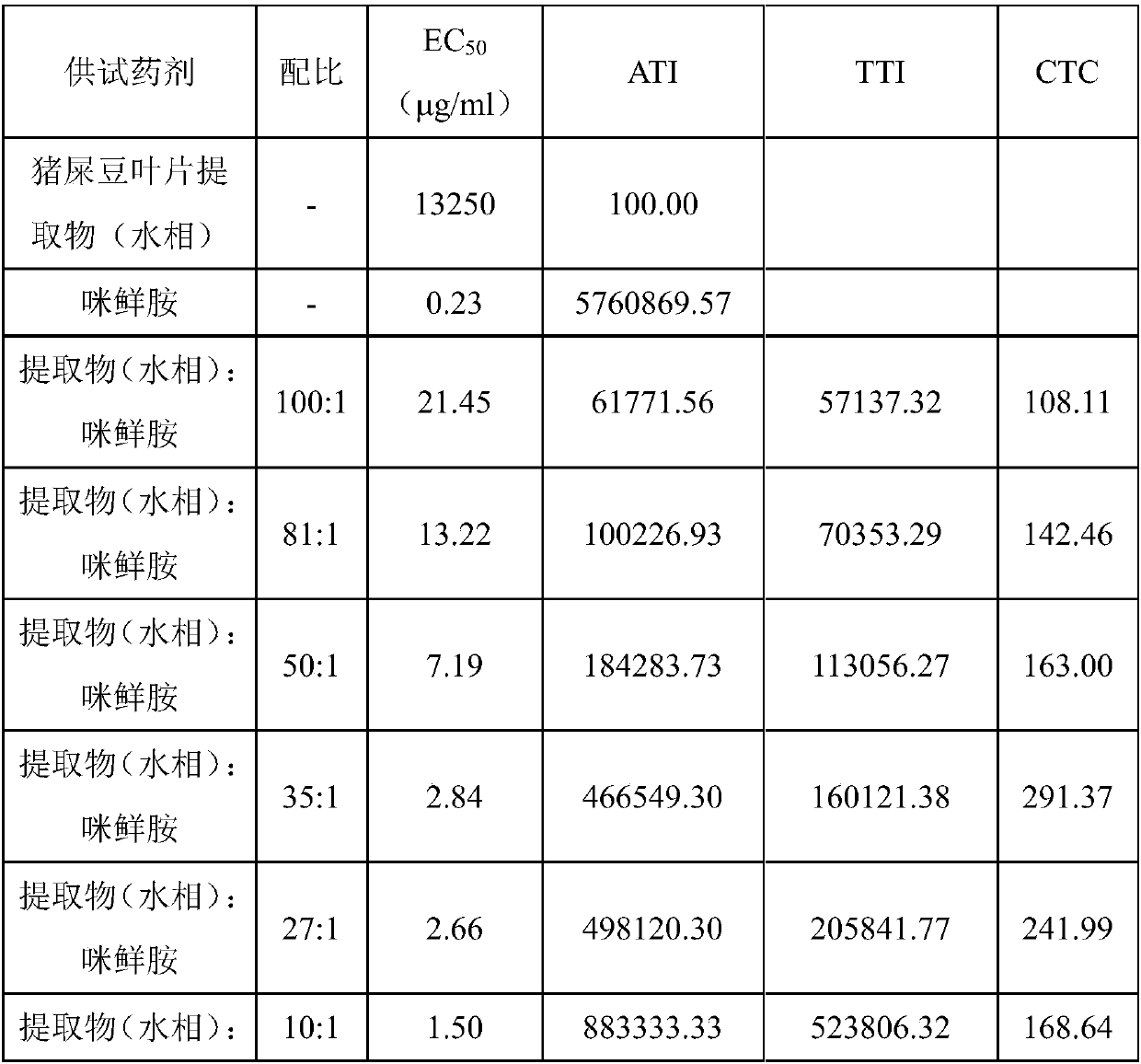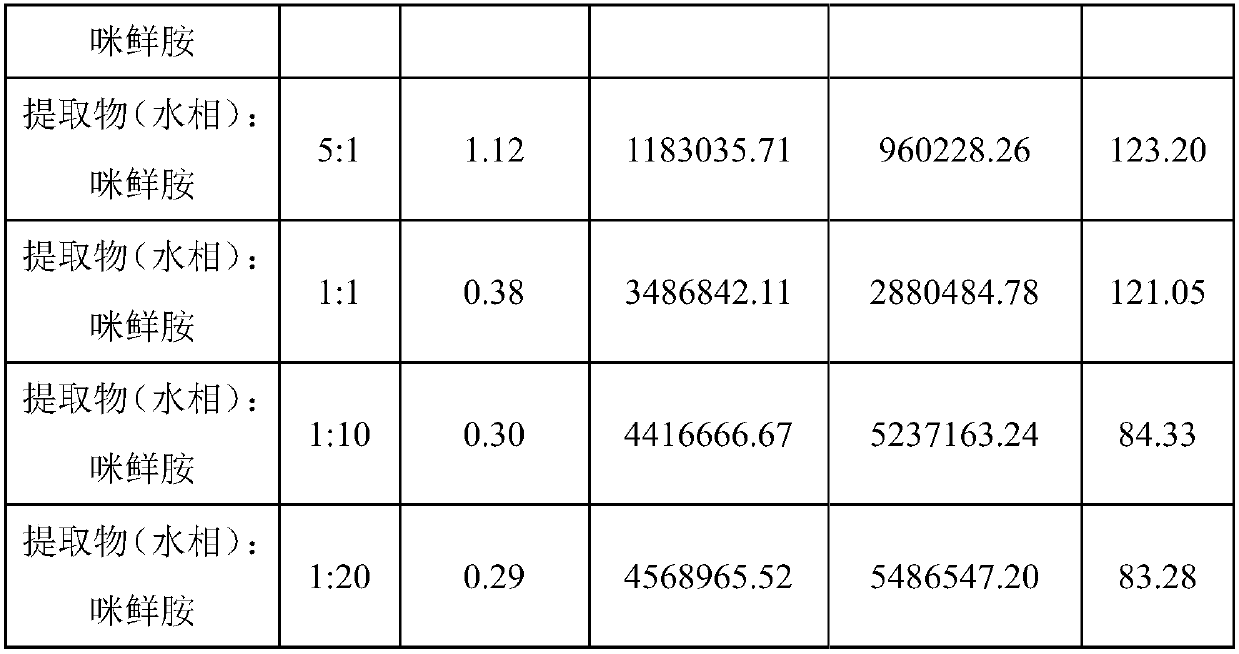Pesticide compound containing prochloraz
The technology of a pesticide composition and prochloraz, which is applied in the field of botanical pesticides and chemical pesticide synergistic compositions, can solve problems such as unreported combinations, and achieve the effects of reducing the use cost, delaying the resistance of diseases and insect pests, and reducing the usage amount.
- Summary
- Abstract
- Description
- Claims
- Application Information
AI Technical Summary
Problems solved by technology
Method used
Image
Examples
Embodiment 1
[0024] Example 1: Extraction of pig's excrement bean extract
[0025] Take 685g of crushed dry sarcophagus leaves, extract with 80% ethanol, reflux extraction in a water bath at 50°C for 3 times, 1 hour each time, combine the extracts, concentrate under reduced pressure, add water to suspend, extract 3 times with petroleum ether, and combine Concentrate to obtain 30 g of extract, then extract 3 times with chloroform, combine and concentrate to obtain 16 g of extract, finally extract 3 times with ethyl acetate, combine and concentrate to obtain 10 g of extract, and finally evaporate to dryness to obtain 82 g of extract.
[0026] For details, see (Journal of Jiangxi Agricultural University, 2014, 36(4):861-867, Wang Fang, etc.) the method recorded in the study of the total flavonoid content and antibacterial activity of the leaf extract of S. chinensis.
Embodiment 2
[0027] The preparation of embodiment two pesticide compositions
[0028] Composition No. 1: Take 350 parts of the leaf extract (aqueous phase) of Solanum japonica, 10 parts of prochloraz, 10 parts of sodium lignosulfonate, 10 parts of fatty alcohol polyoxyethylene ether, 20 parts of sec-butyl acetate, 600 parts of ionized water; mix prochloraz and sec-butyl acetate, shake well, add sodium lignin sulfonate, fatty alcohol polyoxyethylene ether, mix the above ingredients evenly, place them in a container and use a shearing machine at 6000 revolutions per minute machine shearing for 30 minutes to obtain the pesticide composition.
[0029] Composition No. 2: Take 270 parts of the leaf extract (water phase), 10 parts of prochloraz, 10 parts of sodium lignosulfonate, 10 parts of fatty alcohol polyoxyethylene ether, 10 parts of sec-butyl acetate, deionized 200 parts of water; mix prochloraz and sec-butyl acetate, shake well, add sodium lignosulfonate, fatty alcohol polyoxyethylene et...
Embodiment 3
[0032] Example 3 The combined action determination of the indoor virulence activity of Corynespora multiprimum after the leaf extract (aqueous phase) and prochloraz were mixed in a certain proportion (inhibition of pathogenic fungus mycelial growth test-plate method, with reference to NY / T 1156.2-2006; Determination of the combined effect of mixing, refer to NY / T 1156.6-2006)
[0033]
[0034] Actual Toxicity Index (ATI) = (EC of standard drug 50 / EC of test agent 50)×100;
[0035] Theoretical toxicity index TTI = toxicity index of agent A × percentage content of agent A in the mixture + toxicity index of agent B × percentage content of agent B in the mixture;
[0036] Co-toxicity coefficient (CTC) = [mixture measured toxicity index (ATI) / mixture theoretical toxicity index (TTI)] × 100
[0037] According to Sun Yunpei's method, the synergistic effect of drug mixture is evaluated according to the co-toxicity coefficient (CTC), that is, CTC≤80 is synergistic antagonism...
PUM
 Login to View More
Login to View More Abstract
Description
Claims
Application Information
 Login to View More
Login to View More - R&D
- Intellectual Property
- Life Sciences
- Materials
- Tech Scout
- Unparalleled Data Quality
- Higher Quality Content
- 60% Fewer Hallucinations
Browse by: Latest US Patents, China's latest patents, Technical Efficacy Thesaurus, Application Domain, Technology Topic, Popular Technical Reports.
© 2025 PatSnap. All rights reserved.Legal|Privacy policy|Modern Slavery Act Transparency Statement|Sitemap|About US| Contact US: help@patsnap.com



